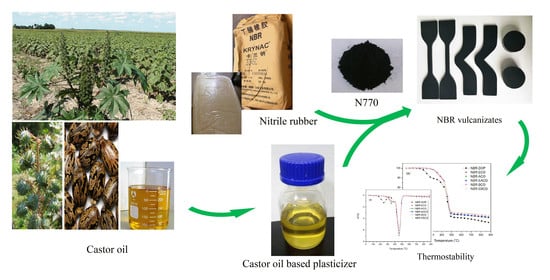Study on the Synthesis of Castor Oil-Based Plasticizer and the Properties of Plasticized Nitrile Rubber
Abstract
1. Introduction
2. Experimental
2.1. Materials
2.2. Synthesis of Epoxy Castor Oil (ECO)
2.3. Synthesis of Acetylated Castor Oil (ACO)
2.4. Synthesis of Epoxy Acetylated Castor Oil (EACO)
2.5. Synthesis of Benzoyl Castor Oil (BCO)
2.6. Synthesis of Epoxy Benzoyl Castor Oil (EBCO)
2.7. Processing of Plasticized Compounds
2.8. Tests
3. Results and Discussion
3.1. FTIR and NMR Characterization of the Synthesized Plasticizers
3.2. Mooney Viscosity Test
3.3. Cure Characteristics
3.4. Physical and Mechanical Properties
3.5. Hot Air Aging Properties
3.6. Oil Aging Resistance
3.7. Glass Transition Temperature
3.8. Thermogravimetric Analysis
3.9. Fracture Surface Morphology Analysis
4. Conclusions
Author Contributions
Funding
Conflicts of Interest
References
- Khalaf, A.I.; Yehia, A.A.; Ismail, M.N.; A Hassan, M. High performance oil resistant rubber. Open J. Org. Polym. Mater. 2012, 2, 89–94. [Google Scholar] [CrossRef][Green Version]
- Srivastava, S.K.; Mishra, Y.K. Nanocarbon reinforced rubber nanocomposites: Detailed Insights about mechanical, dynamical mechanical properties, payne, and mullin effects. Nanomaterials 2018, 8, 945. [Google Scholar] [CrossRef] [PubMed]
- Rajasekar, R.; Pal, K.; Heinrich, G.; Das, A.; Das, C. Development of nitrile butadiene rubber–nanoclay composites with epoxidized natural rubber as compatibilizer. Mater. Des. 2009, 30, 3839–3845. [Google Scholar] [CrossRef]
- Petrović, Z.S.; Ionescu, M.; Milić, J.; Halladay, J.R. Soybean oil plasticizers as replacement of petroleum oil in rubber. Rubber Chem. Technol. 2013, 86, 233–249. [Google Scholar] [CrossRef]
- Rahman, M.; Oßwald, K.; Reincke, K.; Langer, B. Influence of bio-based plasticizers on the properties of NBR materials. Materials 2020, 13, 2095. [Google Scholar] [CrossRef]
- Giuseppe, L.; Claudio, D.F.; Alberto, V. Plasticizers, infant nutrition and reproductive health. Reprod. Toxicol. 2004, 19, 27–33. [Google Scholar]
- De Espinosa, L.M.; Meier, M.A. Plant oils: The perfect renewable resource for polymer science?! Eur. Polym. J. 2011, 47, 837–852. [Google Scholar] [CrossRef]
- Siriwong, C.; Khansawai, P.; Boonchiangma, S.; Sirisinha, C.; Sae-Oui, P. The influence of modified soybean oil as processing aids in tire application. Polym. Bull. 2020, 1–18. [Google Scholar] [CrossRef]
- Boontawee, H.; Nakason, C.; Kaesaman, A.; Thitithammawong, A.; Chewchanwuttiwong, S. Benzyl esters of vegetable oils as processing oil in carbon black-filled sbr compounding: Chemical modification, characterization, and performance. Adv. Polym. Technol. 2015, 36, 320–330. [Google Scholar] [CrossRef]
- Li, J.; Isayev, A.I.; Ren, X.; Soucek, M. Modified soybean oil-extended SBR compounds and vulcanizates filled with carbon black. Polymer 2015, 60, 144–156. [Google Scholar] [CrossRef]
- Kang, C.; Jung, W.; Kim, H.; Jung, H. Highly enhanced tire performance achieved by using combined carbon nanotubes and soybean oil. J. Appl. Polym. Sci. 2020. [Google Scholar] [CrossRef]
- Bétron, C.; Cassagnau, P.; Bounor-Legaré, V. Control of diffusion and exudation of vegetable oils in EPDM copolymers. Eur. Polym. J. 2016, 82, 102–113. [Google Scholar] [CrossRef]
- Petrović, Z.S.; Milić, J.; Ionescu, M.; Halladay, J.R. Epdm rubber plasticized with polymeric soybean oil of different molecular weights. Rubber Chem. Technol. 2017, 90, 667–682. [Google Scholar] [CrossRef]
- Wang, Z.; Han, Y.; Huang, Z.; Zhang, X.; Zhang, L.; Luabc, Y.; Tan, T. Plasticization effect of hydrogenated transgenic soybean oil on nitrile-butadiene rubber. J. Appl. Polym. Sci. 2014, 131. [Google Scholar] [CrossRef]
- Khalaf, A.I.; Ward, A.A.; El-Kader, A.E.A.; El-Sabbagh, A.S. Effect of selected vegetable oils on the properties of acrylonitrile-butadiene rubber vulcanizates. Polimery 2015, 60, 43–56. [Google Scholar] [CrossRef]
- Joseph, R.; Alex, R.; Vinod, V.S.; Premalatha, C.K.; Kuriakose, B. Studies on epoxidized rubber seed oil as plasticizer for acrylonitrile butadiene rubber. J. Appl. Polym. Sci. 2003, 89, 668–673. [Google Scholar] [CrossRef]
- Dasgupta, S.; Agrawal, S.; Bandyopadhyay, S.; Chakraborty, S.; Mukhopadhyay, R.; Malkani, R.; Ameta, S. Characterization of eco-friendly processing aids for rubber compound. Polym. Test. 2007, 26, 489–500. [Google Scholar] [CrossRef]
- Xu, W.; Ge, X.; Jin, L.; Shao, R. Research and application progress of castor oil-based downstream products and castor oil plasticizer. Chem. Ind. Eng. Prog. 2015, 34, 1983–1988, 2002. [Google Scholar]
- Jia, P.; Zhang, M.; Hu, L.; Feng, G.; Bo, C.; Zhou, Y. Synthesis and application of environmental castor oil based polyol ester plasticizers for poly (vinyl chloride). ACS Sustain. Chem. Eng. 2015, 3, 2187–2193. [Google Scholar] [CrossRef]
- Fu, Q.; Long, Y.; Gao, Y.; Ling, Y.; Qian, H.; Wang, F.; Zhu, X. Synthesis and properties of castor oil based plasticizers. RSC Adv. 2019, 9, 10049–10057. [Google Scholar] [CrossRef]
- Intharapat, P.; Kongnoo, A.; Maiwat, P. Bio-processing aids based on jatropha seed oil and its epoxidized derivatives in carbon black-reinforced natural rubber. J. Vinyl Addit. Technol. 2019, 26, 62–76. [Google Scholar] [CrossRef]
- El-Nashar, D.E.; Ahmed, N.M.; Agami, W.R. The effect of new ferrite/kaolin pigment on the properties of acrylonitrile–butadiene rubber composites. Mater. Des. 2013, 52, 108–117. [Google Scholar] [CrossRef]
- Yang, C.; Li, T.; Wan, S.; Huang, X.; Cai, S.; He, X.; Zhang, R. Effect of nitrogen-doped graphene oxide on the aging behavior of nitrile-butadiene rubber. Polymers 2019, 11, 1637. [Google Scholar] [CrossRef]
- Wang, Z.; Peng, Y.; Zhang, L.; Zhao, Y.; Vyzhimov, R.; Tan, T.; Fong, H. Investigation of palm oil as green plasticizer on the processing and mechanical properties of ethylene propylene diene monomer rubber. Ind. Eng. Chem. Res. 2016, 55, 2784–2789. [Google Scholar] [CrossRef]
- Sim, L.; Ramanan, S.; Ismail, H.; Seetharamu, K.; Goh, T. Thermal characterization of Al2O3 and ZnO reinforced silicone rubber as thermal pads for heat dissipation purposes. Thermochim. Acta 2005, 430, 155–165. [Google Scholar] [CrossRef]
- Saad, A.L.G.; El-Sabbagh, S. Compatibility studies on some polymer blend systems by electrical and mechanical techniques. J. Appl. Polym. Sci. 2001, 79, 60–71. [Google Scholar] [CrossRef]
- Arroyo, M.; Lopezmanchado, M.; Valentin, J.; Carretero, J. Morphology/behaviour relationship of nanocomposites based on natural rubber/epoxidized natural rubber blends. Compos. Sci. Technol. 2007, 67, 1330–1339. [Google Scholar] [CrossRef]
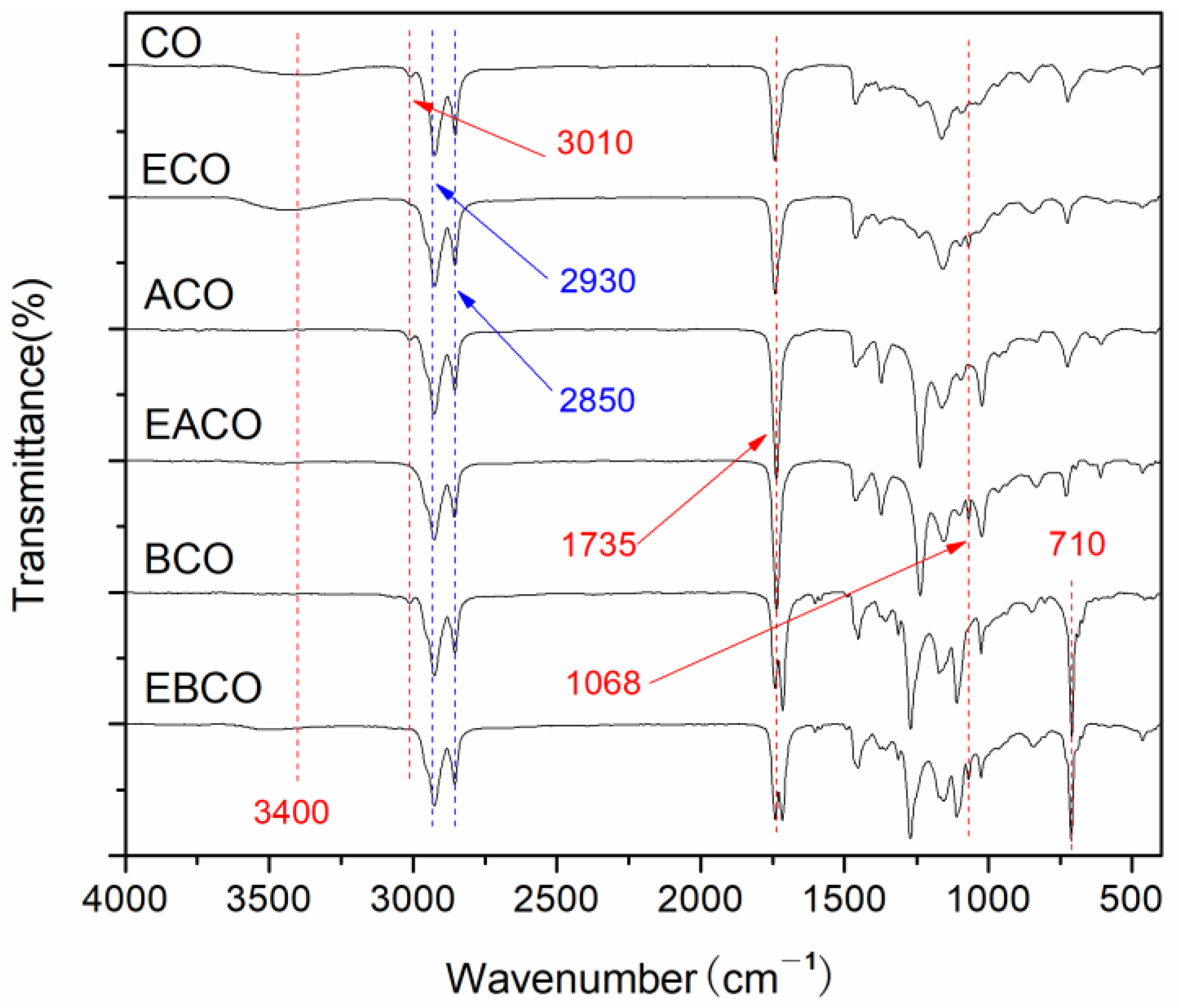
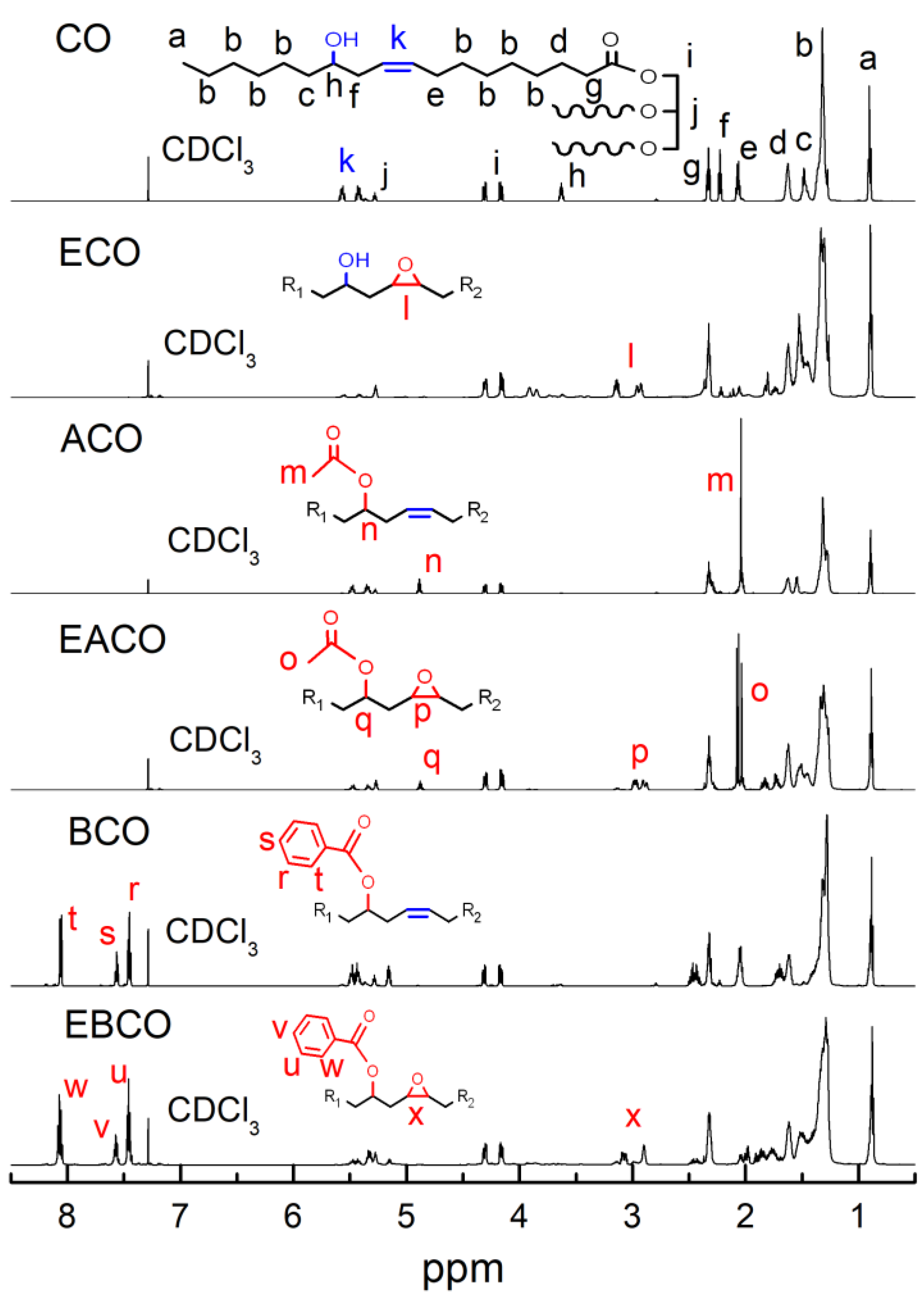
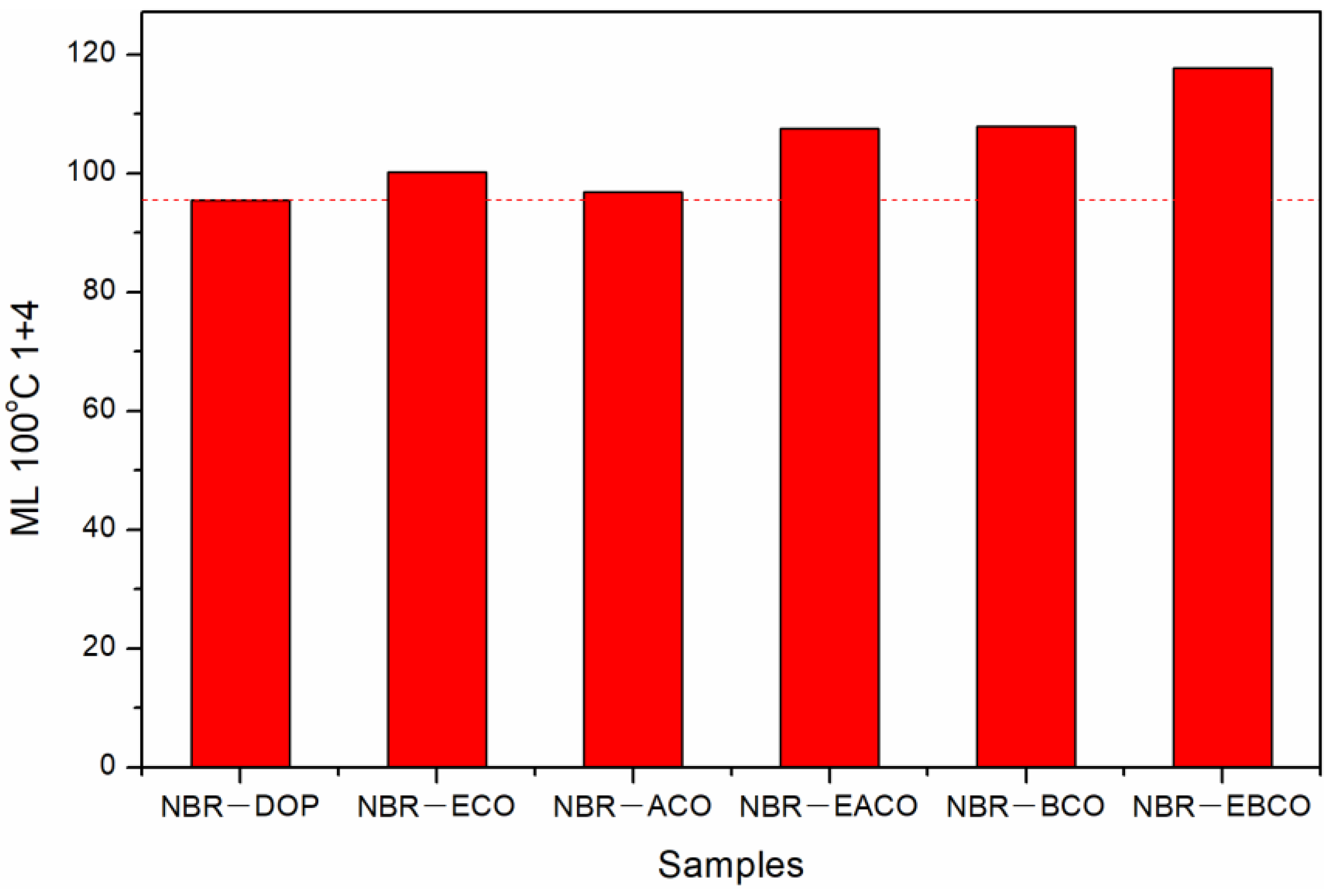
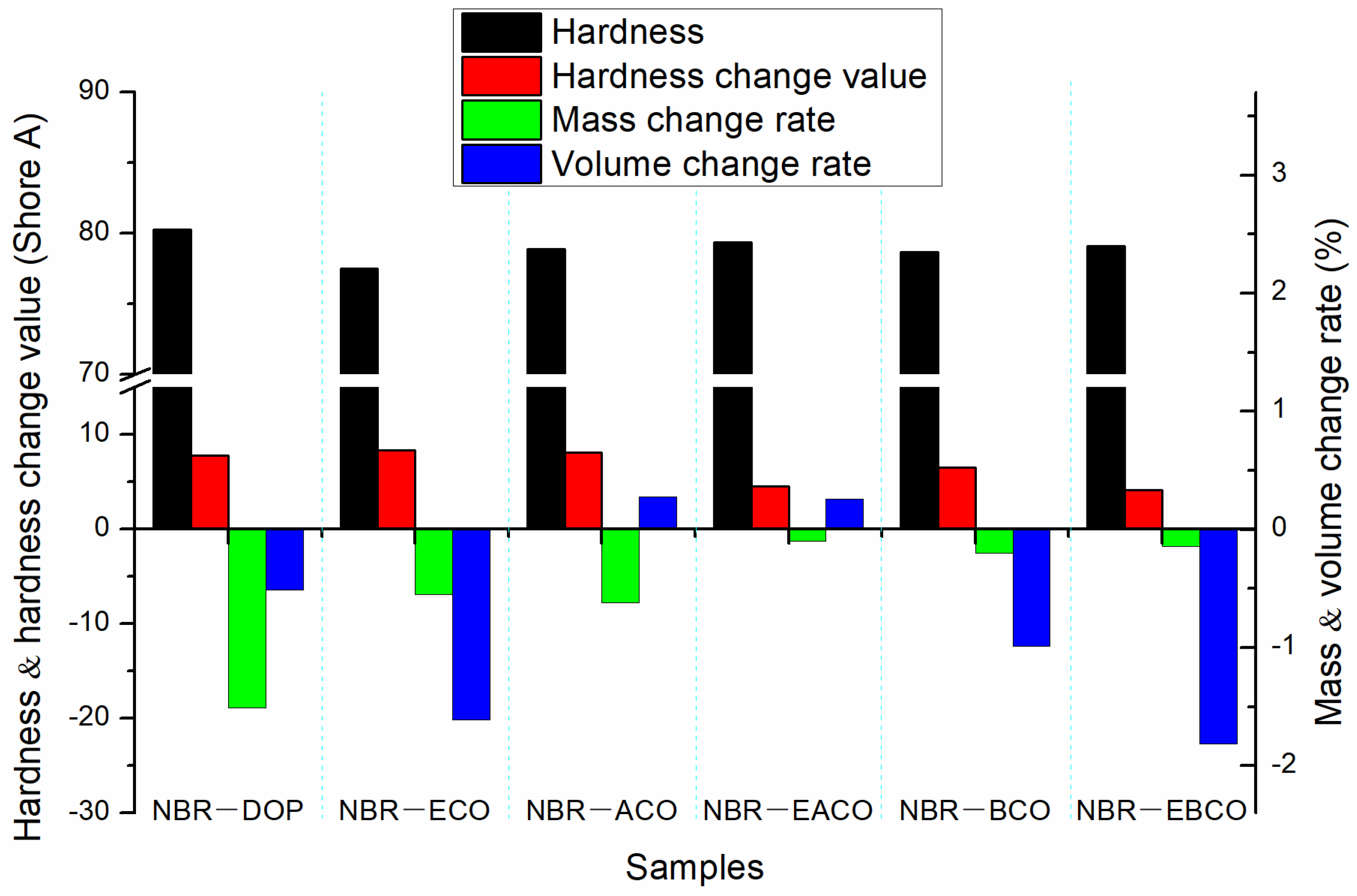
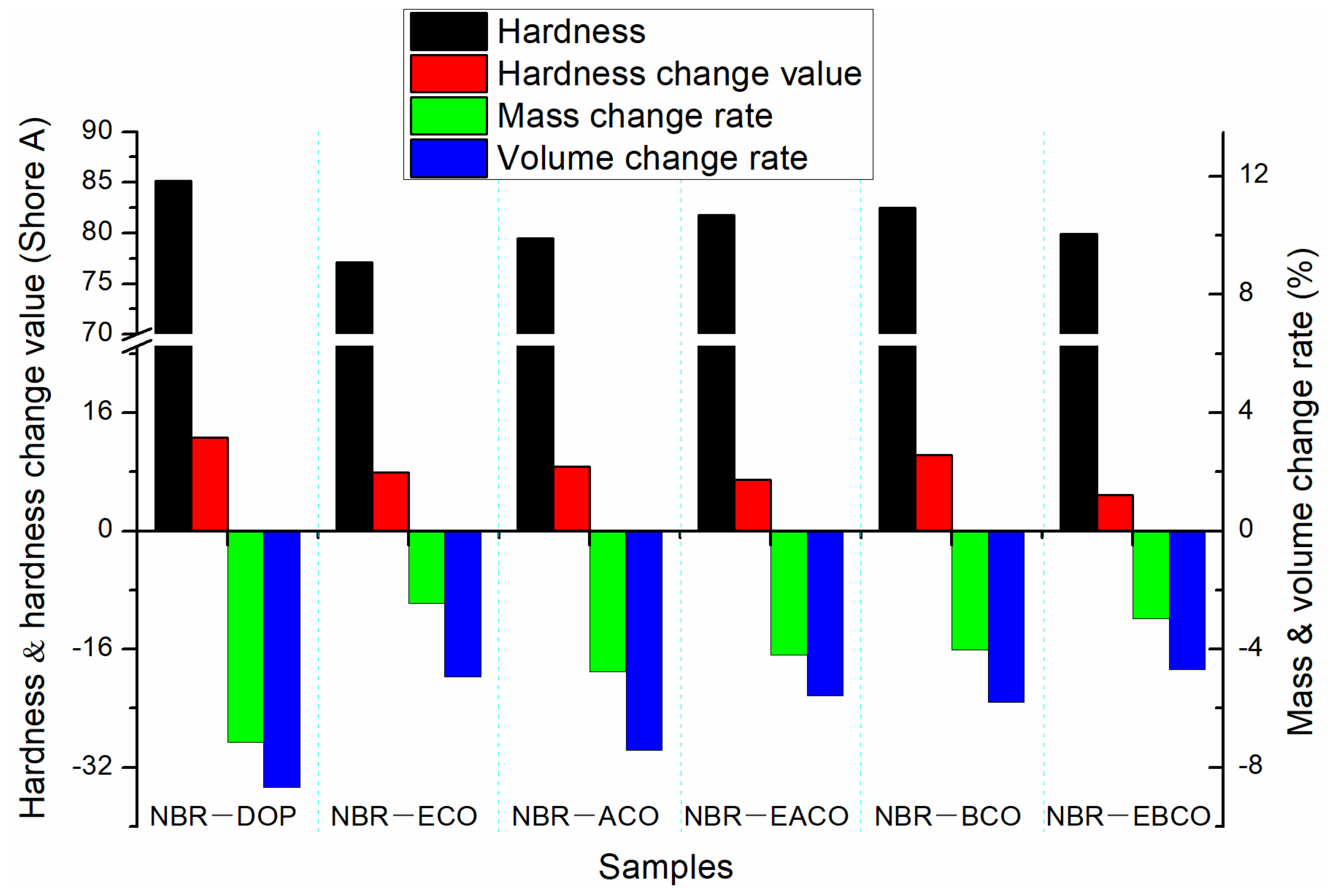
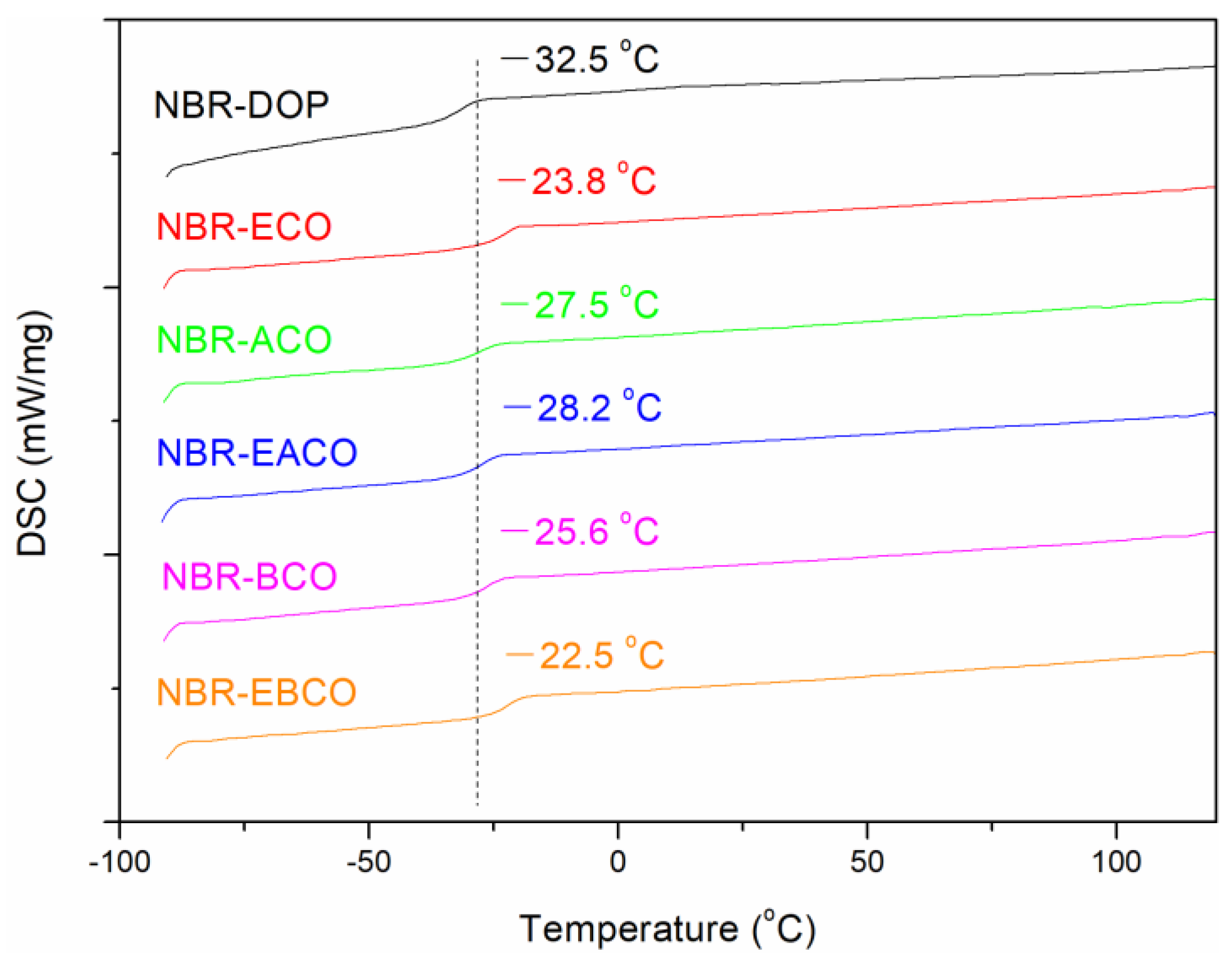
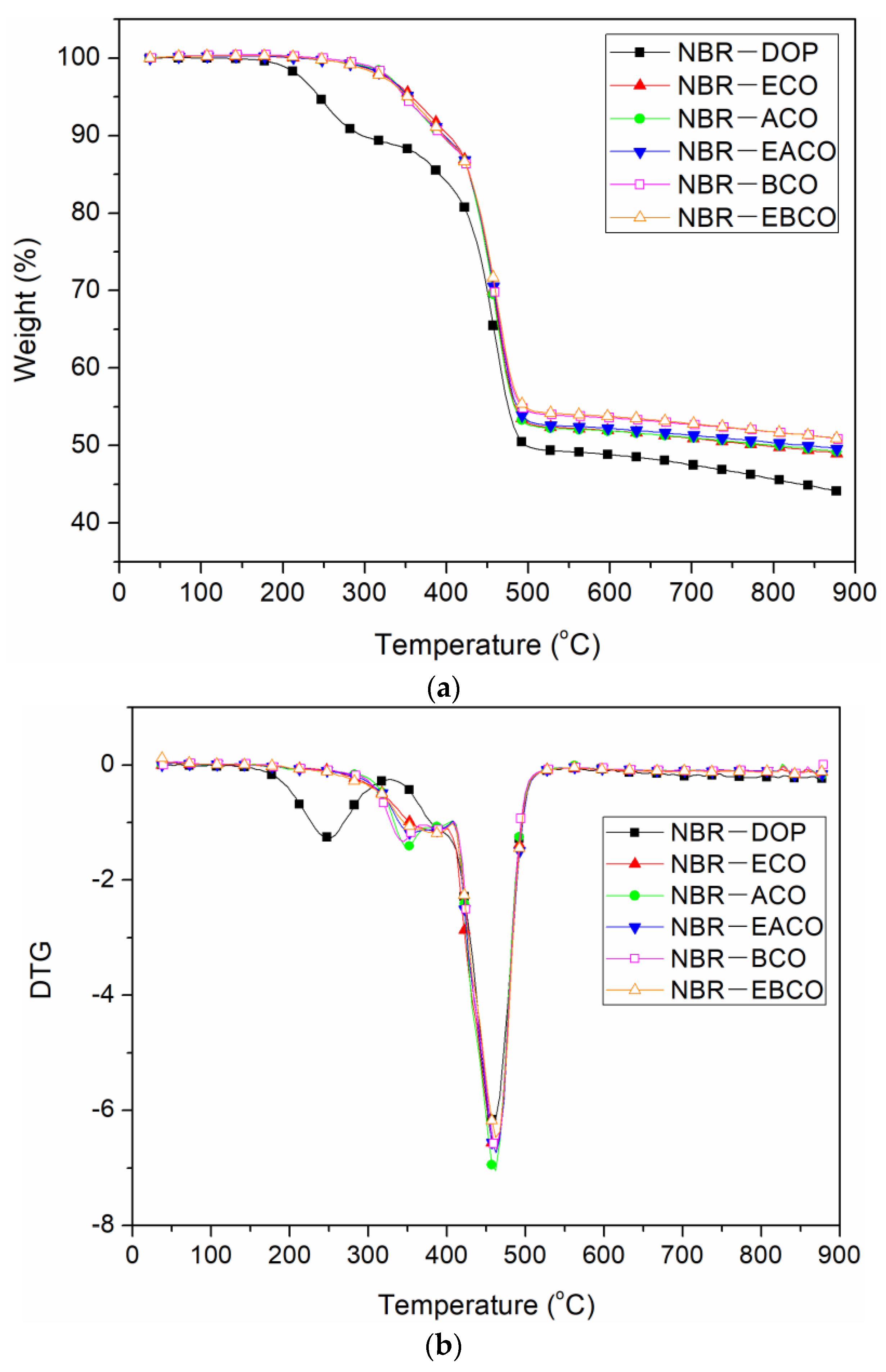

| Plasticizers | Epoxy Value (mol/100 g) | Hydroxyl Value (mKOH/g) | Viscosity at 25 °C (mPa.s) | Tg (°C) |
|---|---|---|---|---|
| DOP | — | — | 80 | −71.6 |
| ECO | 0.23 | — | 2850 | −52.2 |
| ACO | — | 10.06 | 150 | −73.3 |
| EACO | 0.22 | — | 450 | −64.5 |
| BCO | — | 12.99 | 500 | −60.1 |
| EBCO | 0.18 | — | 2200 | −45.2 |
| Samples | MH (Nm) | ML (Nm) | tc10 (min) | tc90 (min) |
|---|---|---|---|---|
| NBR-DOP | 23.27 | 2.16 | 1.57 | 2.97 |
| NBR-ECO | 19.61 | 2.50 | 1.28 | 2.23 |
| NBR-ACO | 19.42 | 2.55 | 1.53 | 3.68 |
| NBR-EACO | 21.48 | 2.57 | 1.43 | 2.60 |
| NBR-BCO | 21.40 | 2.61 | 1.60 | 4.72 |
| NBR-EBCO | 23.62 | 2.73 | 1.50 | 2.62 |
| Samples | TSa (MPa) | EB (%) | S100 (MPa) | TSb (N/mm) | H (Sh A) | CS (%) |
|---|---|---|---|---|---|---|
| NBR-DOP | 17.18 ± 0.68 | 240.25 ± 19.16 | 6.56 ± 0.26 | 57.94 ± 2.36 | 72.5 | 38.72 |
| NBR-ECO | 17.48 ± 0.23 | 289.40 ± 11.00 | 6.04 ± 0.18 | 63.12 ± 1.16 | 69.2 | 57.68 |
| NBR-ACO | 17.52 ± 0.41 | 272.62 ± 11.68 | 6.50 ± 0.36 | 58.06 ± 2.58 | 70.8 | 49.85 |
| NBR-EACO | 17.66 ± 0.54 | 256.37 ± 12.63 | 7.22 ± 0.23 | 60.43 ± 2.34 | 74.9 | 38.47 |
| NBR-BCO | 18.30 ± 0.72 | 245.22 ± 10.64 | 7.12 ± 0.22 | 61.91 ± 1.88 | 73.2 | 38.52 |
| NBR-EBCO | 18.94 ± 0.43 | 257.73 ± 3.51 | 7.78 ± 0.33 | 63.89 ± 2.18 | 75.0 | 39.14 |
| Sample | TS (MPa) | EB (%) | TSCR (%) | EBCR (%) |
|---|---|---|---|---|
| NBR-DOP | 18.98 ± 0.99 | 128.54 ± 9.80 | 10.48 | −46.50 |
| NBR-ECO | 18.70 ± 0.96 | 185.63 ± 16.35 | 6.98 | −35.86 |
| NBR-ACO | 19.64 ± 0.56 | 153.59 ± 6.36 | 12.10 | −43.66 |
| NBR-EACO | 19.10 ± 1.06 | 159.60 ± 17.97 | 8.15 | −36.42 |
| NBR-BCO | 20.60 ± 1.35 | 158.80 ± 8.42 | 12.57 | −35.24 |
| NBR-EBCO | 20.60 ± 0.74 | 168.43 ± 11.87 | 8.76 | −34.65 |
| Samples | TS (MPa) | EB (%) | TSCR (%) | EBCR (%) |
|---|---|---|---|---|
| NBR-DOP | 19.84 ± 1.19 | 128.52 ± 13.14 | 15.48 | −46.51 |
| NBR-ECO | 18.82 ± 0.26 | 190.55 ± 4.62 | 7.67 | −34.16 |
| NBR-ACO | 19.00 ± 0.68 | 154.02 ± 7.78 | 8.45 | −43.50 |
| NBR-EACO | 19.82 ± 0.92 | 155.23 ± 3.07 | 12.23 | −38.16 |
| NBR-BCO | 19.04 ± 1.93 | 123.33 ± 17.40 | 4.04 | −49.71 |
| NBR-EBCO | 20.40 ± 1.21 | 147.20 ± 13.06 | 7.71 | −42.89 |
| Sample | T10% (°C) | Tp1 (°C) | Tp2 (°C) | Residue (%) |
|---|---|---|---|---|
| NBR-DOP | 297.3 | 252.3 | 457.3 | 44.12 |
| NBR-ECO | 402.1 | 382.1 | 462.1 | 48.99 |
| NBR-ACO | 392.1 | 347.1 | 462.1 | 49.26 |
| NBR-EACO | 392.4 | 352.4 | 462.4 | 49.56 |
| NBR-BCO | 394.2 | 344.4 | 464.4 | 50.81 |
| NBR-EBCO | 392.0 | 387.0 | 462.0 | 50.93 |
Publisher’s Note: MDPI stays neutral with regard to jurisdictional claims in published maps and institutional affiliations. |
© 2020 by the authors. Licensee MDPI, Basel, Switzerland. This article is an open access article distributed under the terms and conditions of the Creative Commons Attribution (CC BY) license (http://creativecommons.org/licenses/by/4.0/).
Share and Cite
Fu, Q.; Tan, J.; Wang, F.; Zhu, X. Study on the Synthesis of Castor Oil-Based Plasticizer and the Properties of Plasticized Nitrile Rubber. Polymers 2020, 12, 2584. https://doi.org/10.3390/polym12112584
Fu Q, Tan J, Wang F, Zhu X. Study on the Synthesis of Castor Oil-Based Plasticizer and the Properties of Plasticized Nitrile Rubber. Polymers. 2020; 12(11):2584. https://doi.org/10.3390/polym12112584
Chicago/Turabian StyleFu, Qinghe, Jihuai Tan, Fang Wang, and Xinbao Zhu. 2020. "Study on the Synthesis of Castor Oil-Based Plasticizer and the Properties of Plasticized Nitrile Rubber" Polymers 12, no. 11: 2584. https://doi.org/10.3390/polym12112584
APA StyleFu, Q., Tan, J., Wang, F., & Zhu, X. (2020). Study on the Synthesis of Castor Oil-Based Plasticizer and the Properties of Plasticized Nitrile Rubber. Polymers, 12(11), 2584. https://doi.org/10.3390/polym12112584



